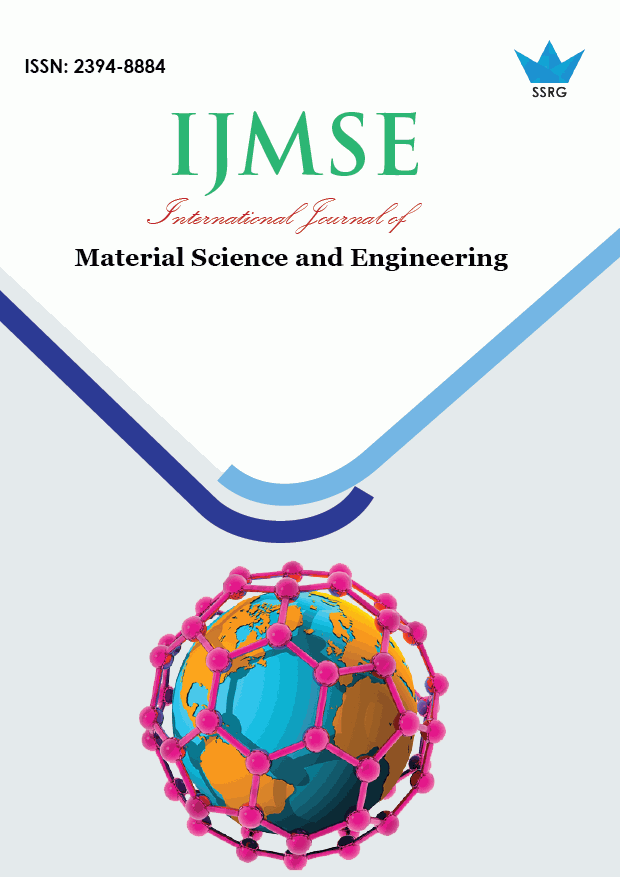Improvement in the Capacity of K-Ion Battery to Supply V-I Capacity in Renewable Technology

| International Journal of Material Science and Engineering |
| © 2021 by SSRG - IJMSE Journal |
| Volume 7 Issue 3 |
| Year of Publication : 2021 |
| Authors : Toqeer Ahmed, Muhammad Rafique, Irfan Ahmed, Rasool Akhter |
How to Cite?
Toqeer Ahmed, Muhammad Rafique, Irfan Ahmed, Rasool Akhter, "Improvement in the Capacity of K-Ion Battery to Supply V-I Capacity in Renewable Technology," SSRG International Journal of Material Science and Engineering, vol. 7, no. 3, pp. 1-8, 2021. Crossref, https://doi.org/10.14445/23948884/IJMSE-V7I3P101
Abstract:
The increase in power consumption has increase the power generation technologies in sustainable manners which leads the renewable energy sources to generate power, but the main issue is to store that generated energy for the future use, this opens the research doors in batteries design for the best performance and long life. From last decays the most research work is going on the K-Ion batteries (PIBs) because of the K-Ion size (1.38Å) which is large than Li-ion (0.76 Å) in radius the carbon-based materials are under consideration for the design of electrode anode. In this work we will observe the properties of K-ion anode based on some modified 1D CNTs materials. With the help of doping electrochemical properties of Carbon based anode can be improved, which enhance the capacity of k ion battery, deliver more energy when connected with load and improves its stability. The discovery of new 1D materials could lead to a better energy storage device, which could help to overcome the limitations of non-conventional energy sources like solar and wind. This piece of work focuses on the main issue of energy storage. The choice of a potassium ion battery is significant due to its numerous advantages over other types of batteries.
Keywords:
K-ion Batteries; Doping; CNTs 1D materials;
References:
[1] Sawicki M, Shaw LL. Advances and challenges of sodium ion batteries as postlithium ion batteries. RSC Adv2015;5:53129e54. https://doi.org/10.1039/C5RA08321D. \
[2] Eftekhari A. On the theoretical capacity/energy of lithium batteries and theircounterparts. ACS Sustainable ChemEng 2019;7:3684e7. https://doi.org/10.1021/acssuschemeng.7b04330
[3] Komaba, S.; Hasegawa, T.; Dahbi, M.; Kubota, K. PotassiumIntercalation into Graphite to Realize High-Voltage/High-PowerPotassium-Ion Batteries and Potassium-Ion Capacitors. Electrochem.Commun., 60 (2015) 172-175.
[4] Marcus, Y. Thermodynamic Functions of Transfer of SingleIons from Water to Nonaqueous and Mixed Solvents: Part 3-StandardPotentials of Selected Electrodes. Pure Appl. Chem, 57 (1985) 1129-1132.
[5] Komaba, S.; Hasegawa, T.; Dahbi, M.; Kubota, K. PotassiumIntercalation into Graphite to Realize High-Voltage/High-PowerPotassium-Ion Batteries and Potassium-Ion Capacitors. Electrochem.Commun., 60 (2015) 172-175.
[6] Okoshi M, Yamada Y, Komaba S, Yamada A, Nakai H. Theoretical analysis of interactions between potassium ions and organic electrolyte solvents: acomparison with lithium, sodium, and magnesium ions. J ElectrochemSoc2016;164:A54e60. https://doi.org/10.1149/2.0211702jes
[7] Xie Y, Chen Y, Liu L, Tao P, Fan M, Xu N, Shen X, Yan C. Ultra-high pyridinicNdoped porous carbon monolith enabling high-capacity K-ion battery anodes for both half-cell and full-cell applications. Adv Mater 2017;29:1702268.https://doi.org/10.1002/adma.201702268.
[8] Zhao J, Zou X, Zhu Y, Xu Y, Wang C. Electrochemical intercalation of potassium into graphite. AdvFunct Mater 2016;26:8103e10. https://doi.org/10.1002/adfm.201602248.
[9] [12] Eftekhari A, Jian Z, Ji X. Potassium secondary batteries. ACS Appl Mater Interfaces 2017;9:4404e19. https://doi.org/10.1021/acsami.6b07989
[10] Luo W, Wan J, Ozdemir B, Bao W, Chen Y, Dai J, Lin H, Xu Y, Gu F, Barone V, Hu L. Potassium ion batteries with graphitic materials. NanoLett 2015;15:7671e7. https://doi.org/10.1021/acs.nanolett.5b03667 .
[11] Wang X, Han K, Qin D, Li Q, Wang C, Niu C, Mai L. Polycrystalline soft carbon semi-hollow microrods as anode for advanced K-ion full batteries. Nanoscale2017;9:18216e22. https://doi.org/10.1039/C7NR06645G.
[12] S. Grimme, Semiempirical GGA-type density functional constructed with a longrange dispersion correction, J. Comput. Chem. 27 (2006) 1787–1799.
[13] J.P. Perdew, K. Burke, M. Ernzerhof, Generalized gradient approximation madesimple, Phys. Rev. Lett. 77 (1996) 3865.
[14] G. Kresse, D. Joubert, From ultrasoft pseudopotentials to the projector augmentedwave method, Phy. Rev. B 59 (1999) 1758.
[15] G. Kresse, J. Furthmüller, Efficiency of ab-initio total energy calculations for metalsand semiconductors using a plane-wave basis set, Comput. Mater. Sci. 6 (1996)15–50.(2017) 16360–16370.

 10.14445/23948884/IJMSE-V7I3P101
10.14445/23948884/IJMSE-V7I3P101